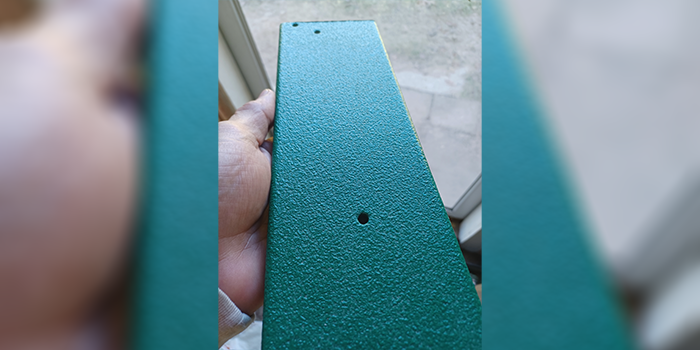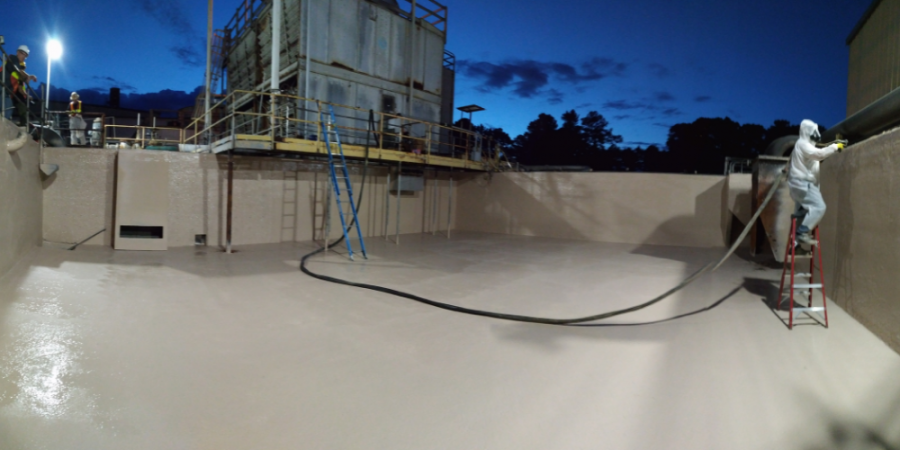Are Polyurea Coatings Systems “Green Coatings”?


SPRAY FOAM MAGAZINE – From recent discussions regarding inquiries asking if the polyurea spray elastomer technology and systems (PUA) being applied would be considered “Green Coating Chemistry” or not, many people suggest that Green Chemistry involves the use of recycled or renewable resources, this is not the only criteria for classification. Using the May 2008 issue of Coatings World magazine (page 48), “The 12 Principles of Green Chemistry” to consider and one will see how the PUA fits. This was originally discussed in the book Green Chemistry Theory and Practice, Anastas, Paul T and Warner, John C, Oxford University Press, New York, 1998.
The article suggests that if the chemistry meets more than one of the 12 points, it can be considered “Green”; the more points the better. Not that it is green in color, although a green colored PUA may fit the requirements of “Green Technology.” So might I opine a bit here and provide some valuable information; as a common sense, educated chemist that follows the science behind it.
renewable Resource Discussion
As some may feel, only Green Chemistry can be based upon a renewable resource, which is a misconception. Yes it is true that polyurea systems are based upon petroleum related products, but hey, so are epoxy and polyurethane coatings. Many utilize the term “fossil fuels” to describe oil, petroleum based products and natural gas with the implication that the oil reserves only came from dinosaurs.
So the definition of fossil fuel: A fossil fuel is a hydrocarbon-containing material such as coal, oil, and natural gas; naturally formed in the Earth's crust from the remains of dead plants and animals, that is extracted and burned as a fuel. And while we no longer have dinosaurs present, there is still vast amounts of organic matter that is naturally decaying. The natural decay process did not stop with the dinosaurs, think about it... Ah, a natural, renewable resource.
That cell phone, handy, or whatever you call it, that you so dearly cherish and can’t live without by the way, would not be possible without utilization of petroleum. The plastic components and electronics on your application equipment make it possible for better controls and data capture many depend on in their work. Your safety equipment, respirators, Tyvek® suits, plastic masking material, etc. are all based upon petroleum products. Wind turbine blades, solar panels and electrical storage devices (batteries) also rely heavily on petroleum based fossil fuel products in production, assembly as well as some operating conditions.
Sure, PUA systems can be based upon, or contain, a renewable resource like Castor Oil, Soy based polyols or even Cashew Nut oil for example. However, two major points to note here. One is that now this is no longer a Polyurea system, but a hybrid Urethane / Urea system. Nothing wrong with hybrid systems mind you, but we are focusing on true polyurea systems.
The other thing to consider when using these types of renewables, which are slower reacting polyols, is either a heavy metal catalyst or other fugitive amine catalyst is typically required to promote that polyol – isocyanate reaction in a timely, fast set coating application. Fugitive, meaning that it is not reacted into the system, but encapsulated and can potentially be extracted out over time. Thus then not meeting one of the other points of Green Chemistry.
the Main Points to consider
For the points to consider, the PUA systems are plural component systems that are processed using specialized, plural component equipment. Mixing of the two components occurs within the spray gun such that there is no loss of material as with other conventional two-part systems. The PUA thus eliminates waste due to non-premixing of components that then may not be required on a project and then disposed of.
The fast set PUA spray systems are 100% solids, containing no solvents or VOC material. The formed elastomer coating and lining system occurs very rapidly in set and cure and does not outgas any materials, and forms an inert, non-hazardous product. These system components are not flammable and relatively safe to use, compared to solvent based systems. Proper bodily and respirator protection is REQUIRED when using these systems, you are dealing with chemicals by the way.
The PUA systems are autocatalytic in reaction nature, no catalyst required. These catalysts used in other systems could potentially leach from the coating system and give rise to environmental issues.
The applied PUA systems are noted for their superior protection of substrates and structures they are applied to. This thus preserves the structure and environment, a very important point! While general polyurea spray coating systems are not anti-corrosion coatings by themselves, they are barrier coating designed to protect the substrate they are applied to from various types of damage. This would include erosion, chemical attack, waterproofing, etc.
One of the large application uses for the polyurea technology is in the form of secondary containment around storage tanks of flammable or hazardous chemicals. This of course can be a major environmental issue in the case of spills or leaks, and the applied polyurea systems ensure protection against groundwater contamination.
Another major use of course is in rehabilitation of our aging infrastructure systems. This included service manhole lings, trenchless pipelining work, clarifier and waste-water treatment facility linings. The rapid speed of application and faster return to service is a large benefit, and reduced inconvenience to the general public is a plus.
Believe it or not, removed polyurea spray coatings (or other produced parts) can be recycled. This is discussed in European Patent Application EP00569194A1, “Production of Polyureas Using Recycled Polyurethanes and Polyureas,” 1993 (Grigsby, Dominguez, Primeaux and Cuscurida). While there’s not so much widespread use, or really economical at present, mainly due to limited availability of material for recycling, the process does work and is feasible.
With another recycle use in a cryogenically powdered form is as a propant material in drilling fluids or base material as a thickener in production of polyurea greases. Look it up, there’s plenty of information on that subject.
Final thoughts and conclusion
To our knowledge, there is no one coating technology that would meet all 12 points for Green Chemistry that is a commercially viable material. There’s quite a bit of work-in-progress at major universities and companies, so we look forward to commercial advancements in that area.
So as one can see and hopefully understand here – Yes! Fast set polyurea spray coating systems can in fact be considered as a Green Chemistry material. Thus meeting the “Rules of the Game” as provided to us. It’s all about education and having a bit of common sense here.
ABOUT THE AUTHOR Dudley J. Primeaux II is the owner of Primeaux Associates, LLC, a polyurea technology and application consulting company. He has been directly involved in the polyurea story since the early development in the1980s. His background is in Organic Chemistry, where he holds a Master of ScienceDegree. He also has a very high degree of mechanical abilities, which proves useful in field application /equipment usage.Dudley has authored over 40 technical papers relating to the polyurea industry, is named inventor on over 25 U.S. Patents and eight European Patents. He has experience in the preparation of new raw materials, formulation development, application equipment usage, field application work, and failure analysis of coating / lining projects. He knows more about “polyurea” than most in the industry
For use by SprayFoamMagazine.com & Spray Foam Magazine

Disqus website name not provided.










































